Richie Gillham and Rob Sawyer
Baseball may be a minority sport in the UK, but 80 years ago Merseyside was a hotbed of this popular American pastime. Had it not been for the outbreak of War in 1939, perhaps it would have gained a proper foothold in our sporting life.
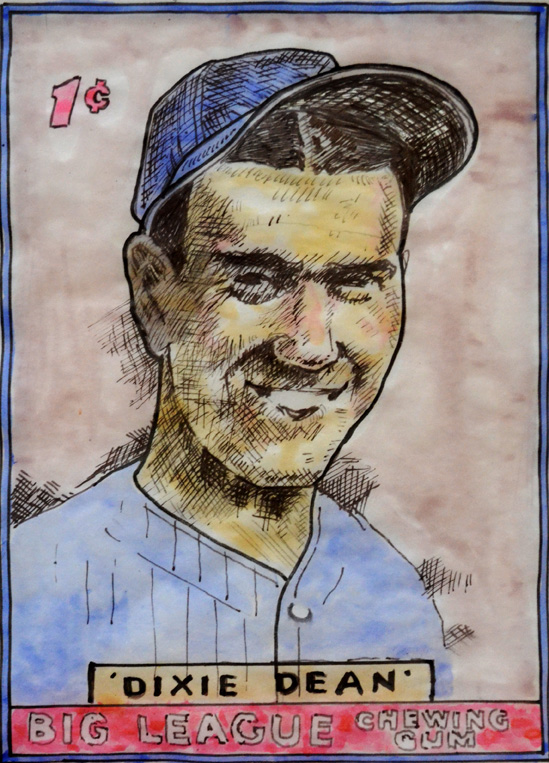
Folklore has it that William Ralph ‘Dixie’ Dean was once introduced to the legendary Babe Ruth (of Boston Red Sox and New York Yankees fame) at a football match. Dean recalled to journalist John Roberts his encounter with Babe. The American introduced himself in typical style by booming: “You’re that Dixie Dean guy! Jeez, you’ll get some cash today.” When Dean explained that his wages – capped at £8/wk – were not linked to the number of spectators through the turnstiles, Ruth reportedly exclaimed: “Jesus Christ! I’d demand two-thirds of this gate!” Dean, himself, would dabble in the American sport when he turned out for Blundellsands and Liverpool Caledonians in the 1930s, but Everton’s connections to baseball go far beyond this. In fact, a baseball team existed in Everton as early as the first decade of the 20th century. The club, not linked to its footballing namesake, was defunct by the end of the First World War.
Thanks to Liverpool’s maritime links to the USA, Everton hosted exhibition matches at Goodison Park in the 1920s. Most notable was the Chicago White Soxs’ victory over New York Giants before a crowd of 2,500 on 23 October 1924.
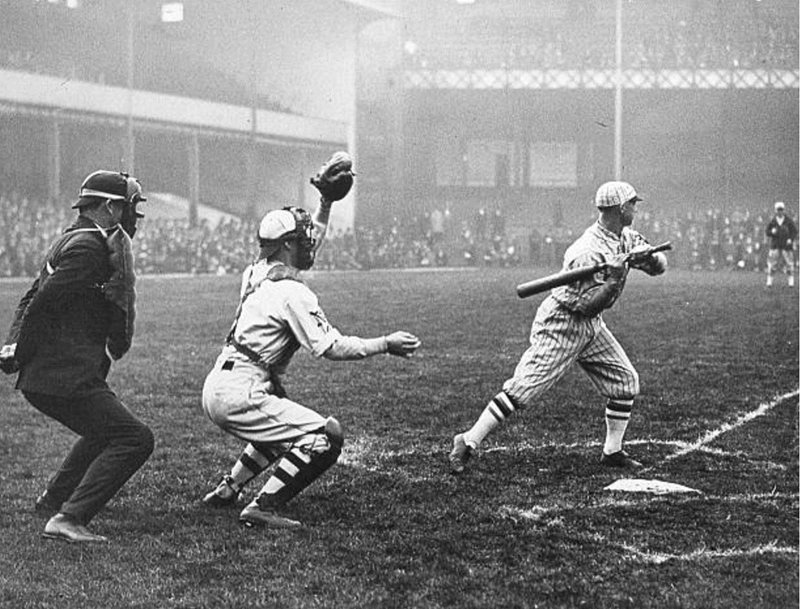
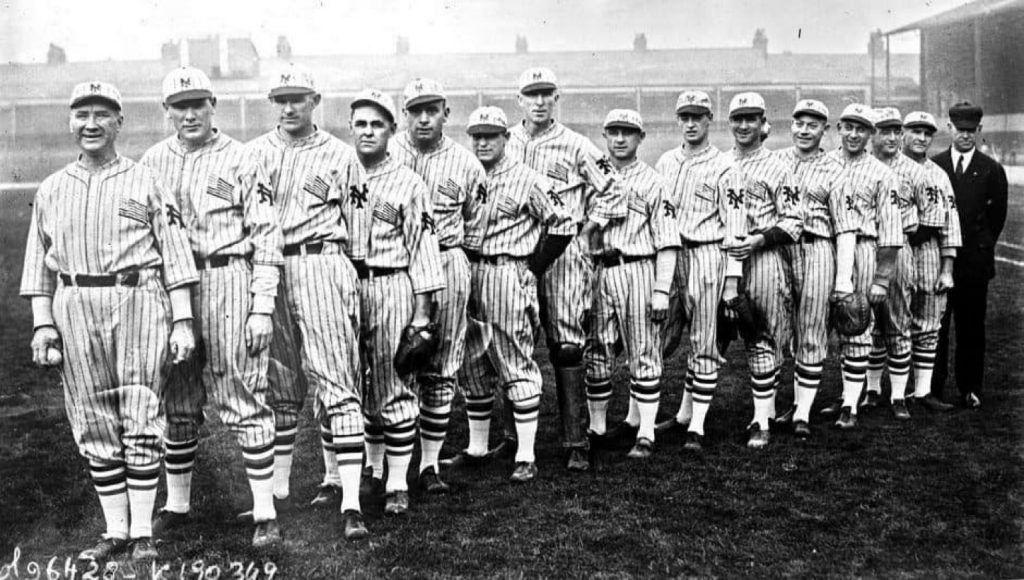
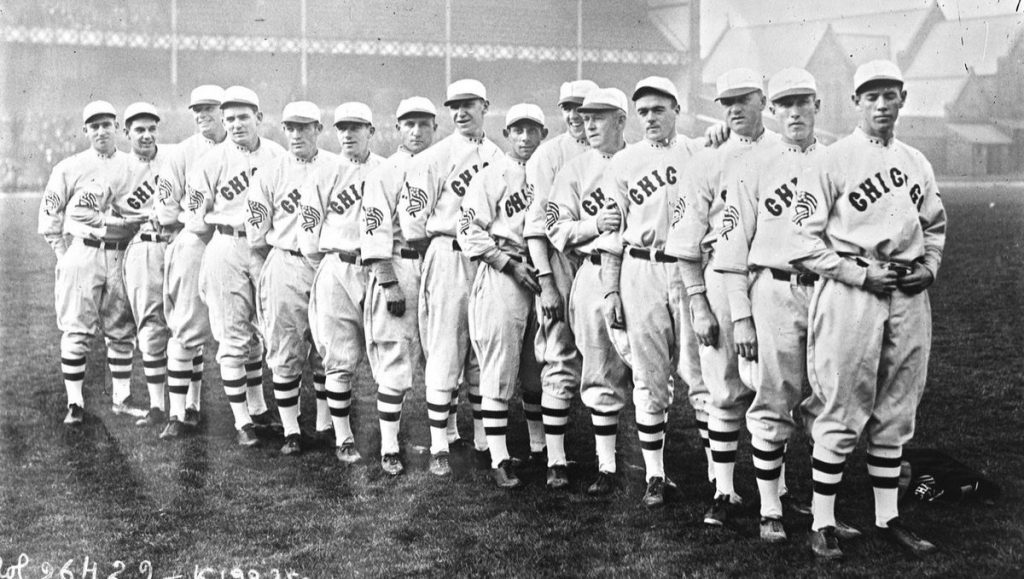
Perhaps inspired by the visit of the American teams, John Moores, the Littlewoods entrepreneur and future Everton chairman, launched a crusade (costing £1 million at today’s prices) to embed baseball as a spectator sport on these shores. In 1933, he created the National Baseball Association and convinced 18 local teams from the Liverpool area to create a league. Other leagues were also set up in other regions, in London and Yorkshire, amongst other locations.
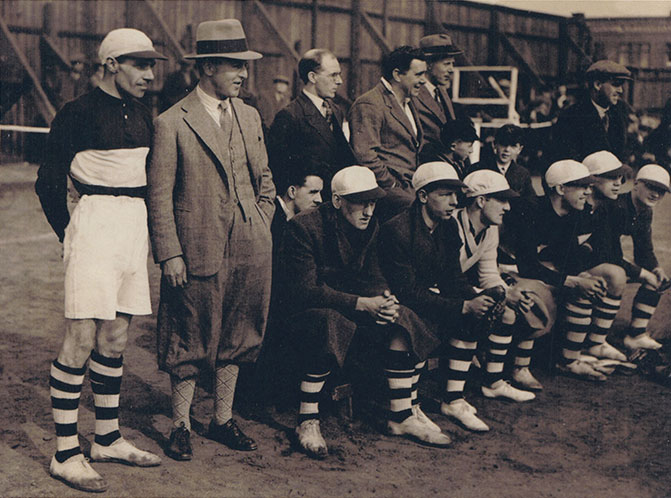
In 1936, The British NBA was restructured with Moores installed as President, and Everton director, Ernest Green, appointed as vce chairman. J.C. Rouse of Liverpool FC was honorary treasurer whilst Everton’s secretary, Theo Kelly, was also on the committee. The Everton chairman during the Second World War, Bill Giddins, was also keen on baseball. He allowed Goodison Park to play host a baseball league in which locals took on American servicemen stationed in the area. The home plate was in the corner between the Gwladys Street and Bullens Road stands.
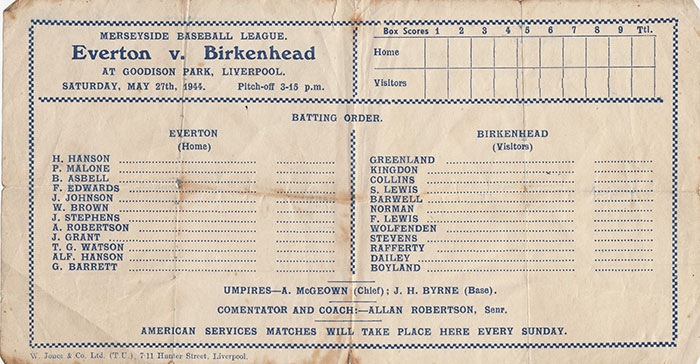
In 1943, Theo Kelly helped raise £1,000 for the British Red Cross and St John’s Fund in a charity game. He also helped to develop the sport on Merseyside by setting up youth team matches between Everton Cubs and the likes of Caledonian Cubs, Formby Cubs, Tranmere Cubs and Fazackerley Cubs. On 18 May 1944, the Everton FC Baseball Club – coached by Kelly – played its inaugural game against Rootes in Speke. Gordon Watson and Jackie Grant, both members of the football team, made their baseball debuts. Throughout the season, the Everton players were hitting the top of the league statistics charts. George Jones topped the batting averages whilst Gordon Watson topped the fielding with zero errors for 1,000.
The following year, Kelly formed the Lancashire County Baseball Association; he also helped to establish a team called Halton Trojans. The last game of baseball staged at Goodison Park came in the 1948, in the Lancashire Cup Final contested by the Trojans and Formby Cardinals. Subsequently, the Trojans would play their fixtures at Bellefield before disbanding in 1958. The reformed club, now known as Liverpool Trojans, plays today at Bootle Stadium as the Liverpool Trojans.
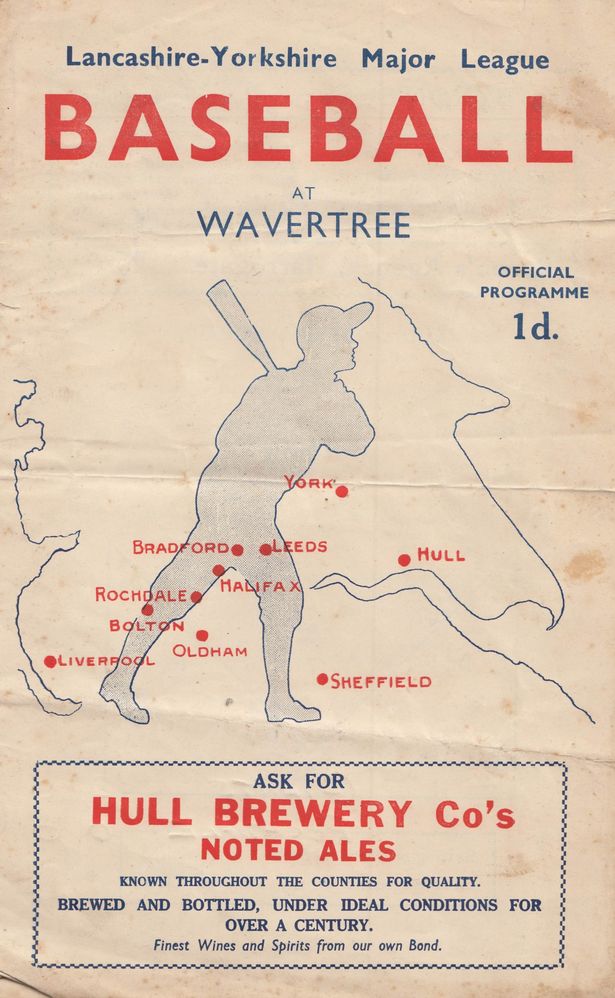
Recently Ted Bulmer shared some keepsakes with EFC Heritage Society that his great uncle George Barrett had from playing for Everton Baseball Club as well as Formby Cardinals and Patricroft. Sadly George spoke little of his time playing the sport before he passed away. Also, Joe Stephens got in touch about his namesake grandfather, who played baseball either side of the war, including for Everton. A docker by trade, he was nicknamed ‘Socks’ (or Sox) Stephens – perhaps as a nod to his baseball prowess.
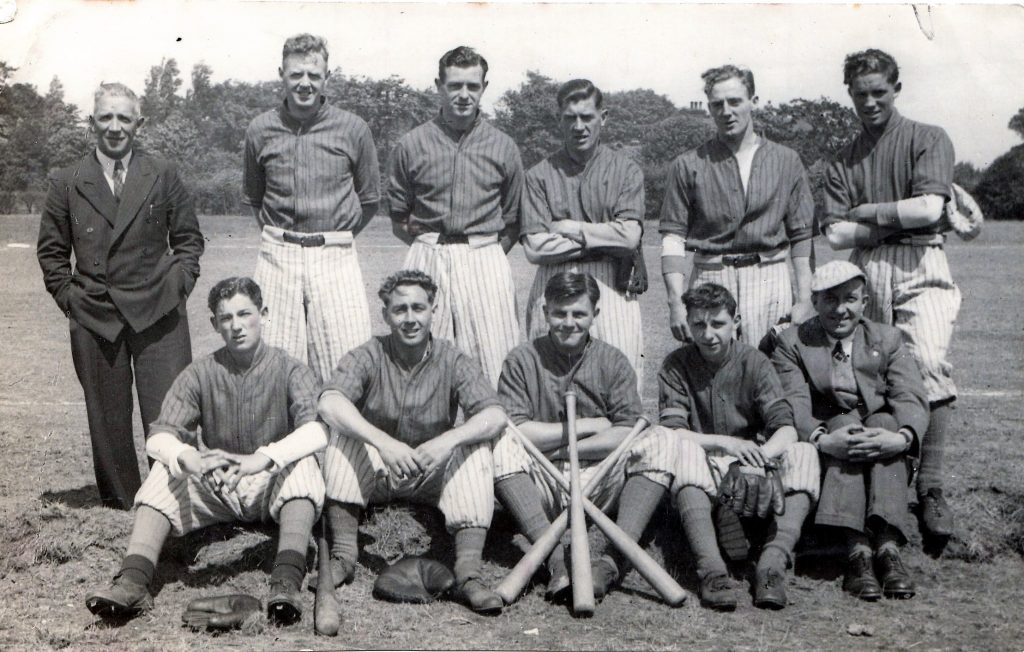
——————————————————-
“The Coward Brothers and the Rise of Baseball in Merseyside: From Goodison Park Glory to Post-War Persistence”
Richie Gillham
Recently, this author had the pleasure of meeting Larry Coward who has a proud history of baseball in his family. His father and his uncles all played for the Liverpool Caledonians at Goodison Park in the 1940s when that was their home ground, being permitted to share with the footballers of Everton FC.
Larry was evacuated as a child twice during World War Two; he remembers the family members talking about playing baseball, and also returning to Liverpool after his first evacuation and seeing Lewis’s on fire during the May Blitz of 1941. He wasn’t involved in the baseball scene until 1946; acting as a scorer at the games, checking base wins, home runs and strike outs.
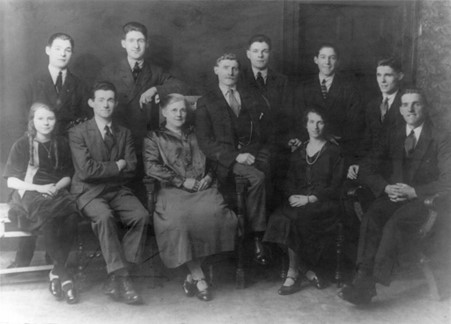
[Larry has supplied the Heritage Society with some superb photographs and a winners shield from the Merseyside National Baseball League, which is proudly displayed with the Heritage Society football memorabilia in St Luke’s church hall.]
Sporting families such as the Cowards, the Robertsons, and the Pages would help develop the game of baseball within the historic setting of Goodison Park. Their presence in the game would help it navigate its transition from baseball’s war time peak to its post-war challenges.
This story is woven into the rich tapestry of local baseball, which saw both footballers and American military personnel contribute to the sport’s popularity in Merseyside during and after World War II. Theo Kelly of Everton was the league’s chairman and administrator, with the league’s headquarters being Goodison Park.
Just a note on the Robertson Family; Mr Alan Robertson Snr (formerly of the Caledonians and Everton FC Baseball) set up training schemes to produce young players. Alan would become a big part of the game not only as an official but also as a commentator (someone essential for motivating the crowd during games).
The Giants of 1936
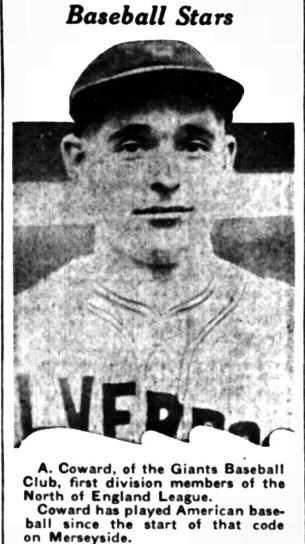
“The five brothers Coward have signed for the Liverpool Giants which is not only unique, but shows a determination to make their mark in the professional league.”
Liverpool Echo, 2 May 1936
Alf and Peter participated in the Giant’s side with Henry (known as Tom), Richard (Dick) and William. The brothers would later become prominent on the baseball scene around Merseyside, participating in the North of England, Lancashire, and Merseyside competitions.
The Giant’s first game was away against the Bolton Scarlett’s, where they won 12 runs to four. Later in the month, Alf and Peter were selected to play against the Ashton Hawks, where the Giants amassed 37 runs to Ashton’s fifteen. Peter Coward, who was becoming a star catcher, had a perfect day with three home runs over the left field stand. The Hawks made a comeback in the last three innings, amassing 12 runs, but were pushed back as the Giants hit 7 more home runs (which was a league record at the time). The crowd were treated to the sight of Alf Coward hitting three runs, his brother hitting two, and the former Kansas City player, Eddie O’Melia knocking the ball over the fence at centre field.
At times, players were loaned to other divisional sides. Alf and Peter, for example, were loaned to the Liverpool Royals in the second division, where they helped them beat the Bolton Scarletts 18-2.
The Giants played a friendly at the West Ham stadium, but the West Ham side was far too strong for them. Alf injured his neck during the game, despite striking out two home team players. It wasn’t to be their day, the game ending in a 16-2 defeat.
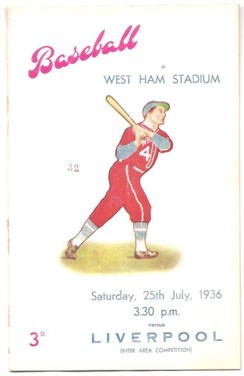
Courtesy of Anthony Taylor – Project Cobb website
Tom played for the Giants at the Stanley track home pitch, participating in a 14-7 defeat by the Oldham Greyhounds.
Alf was soon back in action for the Giants against the Seagulls from Blackpool, where he caught two in a 9-8 win. Alf was also chosen to play for Alf Hanson’s side against Dixie Dean’s side in a benefit game for Liverpool Albion pitcher, J Culey who had been injured in a league fixture.
While Peter was doing his bit for the Royals in the second division with 12 strikeouts, unfortunately, his side could not help out in the 20-13 defeat to Patricroft Lions from Eccles.
The Rise of the Caledonians and the Coward Family
In 1937, Richard Coward and his brother Alf were emerging talents in the Liverpool baseball scene. Alf was already an established catcher, while Richard was known for his fielding and strong batting as a shortstop for the Caledonians. They, along with their siblings, Peter, Dick, and Tom, would become integral members of the team throughout the late 1930s and into the war years.
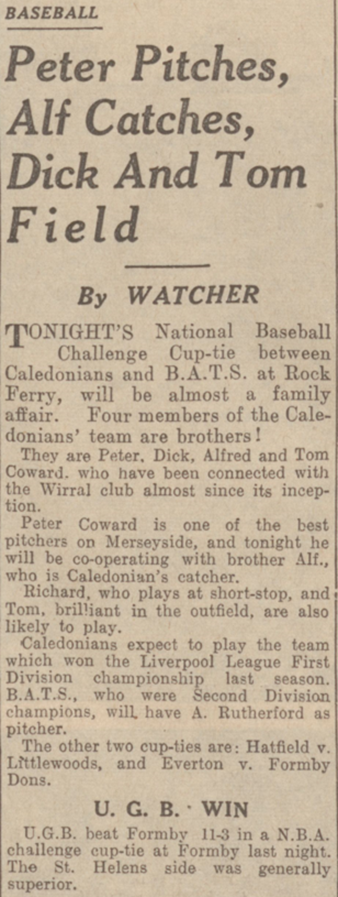
The Caledonians, who became known as The Callies, competed fiercely in the local leagues. Notably, they made significant strides in the North of England League and later the Liverpool National Baseball League, frequently appearing in key games against local rivals, including Everton’s baseball team.
Baseball at Goodison Park
Baseball took on a new significance during World War II, with many matches played to raise funds for war efforts. Goodison Park became a key venue for the sport, hosting many significant games between local teams like the Caledonians and Everton’s baseball team. The Coward brothers played an effective role during these games; Peter Coward, for example, often received praise for his fast pitching and strong batting. His consistent performances on the mound contributed to many of the Caledonians’ victories, especially against Everton.
In 1943, the Cowards and their Caledonian teammates played several charity games at Goodison, including a thrilling match against the American Military Police team, the ‘Nitesticks.’ These games drew large crowds, underscoring the community’s engagement with baseball during the war.
Everton and the Rivalry with the Caledonians
The rivalry between the Everton FC Baseball Club, who were fondly called the Footballers, and the Caledonians, reached its peak in the mid-1940s. Everton, with players like Alf Hanson, a former footballer turned baseball star, and T.G. Watson, challenged the Coward family and the Caledonians for local dominance. Matches between these two teams at Goodison Park became the highlight of the local baseball season, often drawing crowds of thousands.
In 1944, the Caledonians maintained an impressive unbeaten streak in the Merseyside National Baseball League, with the Coward brothers leading the charge. However, Everton managed to break that streak in the Lancashire Cup final, narrowly defeating the Caledonians 12-11. Despite this setback, the Caledonians would eventually win the league title, cementing their legacy as one of the most successful baseball teams in Merseyside.
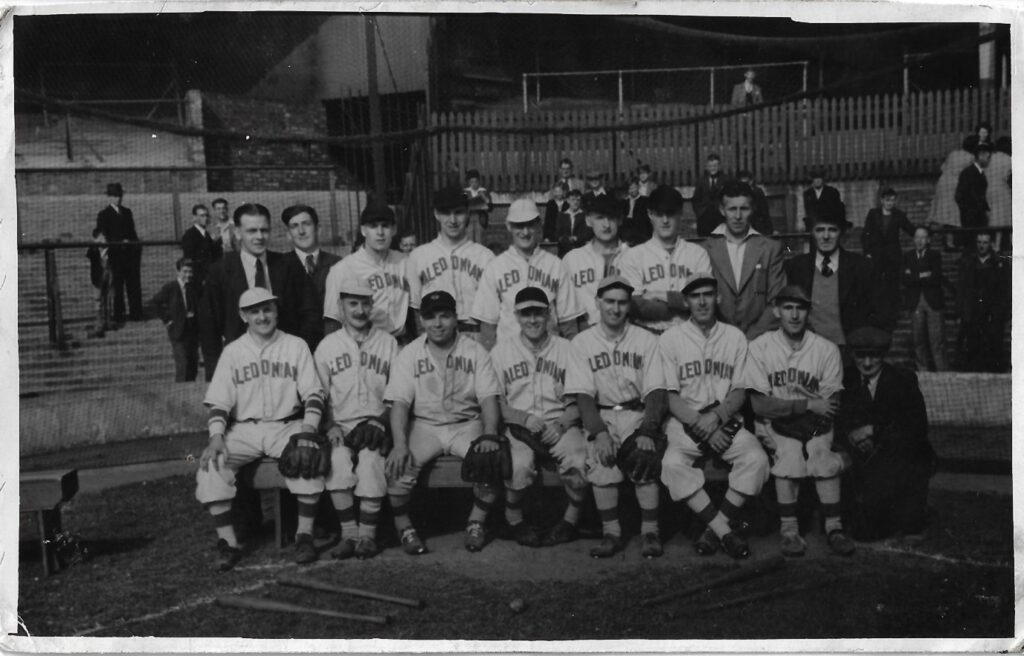
Decline of Baseball at Goodison Park
By the late 1940s, baseball’s popularity in Merseyside began to decline, and the last recorded game at Goodison Park took place in 1948 during the Lancashire Cup final between the Liverpool Trojans and Formby Cardinals. The decline was attributable to their parental football side’s concerns that their players would get injured in baseball and therefore not be available for football matches. Additionally, the pitch at Goodison would need to be constantly re-marked and the grass would be worn away around the diamond-sized baseball pitch.
By the early 1950s, the once-thriving baseball scene at Goodison Park, had shifted to smaller venues like Bellefield, Everton FC’s training ground. The Liverpool Cubs, Pirates, and other teams still competed, but the grand spectacles of the 1940s were fewer. Despite this, the Coward brothers remained key figures. Richard and Peter were still regarded as some of the best players in the region, with Peter’s exceptional pitching and Richard’s leadership on the field provided the backbone for their team, the Liverpool Caledonians.
As the sport struggled to regain its pre-war status, Richard took on more of a leadership role within the team, often acting as captain and helping to nurture younger talent. Peter, meanwhile, continued to excel as a pitcher, earning a reputation for his precise control and ability to outthink batters. Their efforts helped maintain a sense of continuity and passion for the sport, even as football once again dominated Merseyside’s sporting culture.
Although baseball’s popularity waned, the Merseyside National Baseball League continued in a diminished form. Richard and Peter participated in various local competitions, ensuring that baseball still had a presence, even if it no longer commanded the same crowds. Matches were often played at venues like Bootle Stadium and smaller local parks. But by the late 1950s, the Coward brothers had become some of the last links to the golden era of Merseyside baseball.
Richard, went on to become the Honorary General Secretary of the Baseball Association, collaborating with Theo Kelly and John Moores. In 1952, he went on to manage the Great Britain side in the Netherlands, losing both games to the home nation as part of the Dutch Queen’s Jubilee. They lost the first game in the capital city Amsterdam, to the senior side 5-3, with three errors leading to as many Dutch Home runs. The next day in Rotterdam, the Dutch Seconds also beat the GB side 3-1, with a late flourish of three home runs in the last innings. There was no shame in the two defeats as the Dutch game had been forty years in the making.
The Coward family commitment to baseball through the early 1950s, helped preserve the sport during its decline, ensuring that younger generations could still experience the game, even if on a smaller stage.
Richie Gillham
Acknowledgements
Rob Sawyer
Larry Coward
Brendan Connolly, proof reading
Bibliography
Liverpool Echo, various editions, 1937-1950s.
Liverpool Evening Express various editions, 1937-1950s
British Newspaper Archive, 1937-1952.
Liverpool Post & Mercury 1937- 1946
Liverpool Trojans online, https://www.trojansbaseball.co.uk/story
British Baseball Hall of Fame online http://projectcobb.org.uk/bbhof/
Smith, Billy Blue Correspondent website https://bluecorrespondent.co.uk/
Mike Royden – final proofing, editing and web page layout.

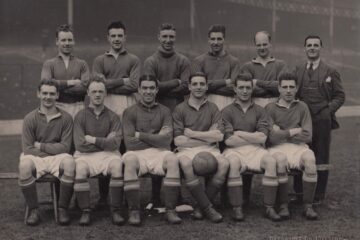
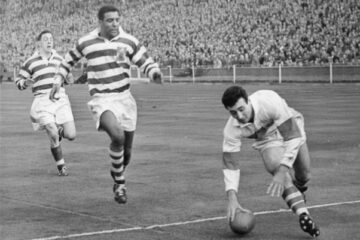

A friend who attends Everton in the community social gatherings mention a member who was part of the baseball at Everton during or after WW2, He heard a name Tom Bevis (aged 105 yrs ) who attends the social functions . I was interested to find who the person was and his record (if any) Can you let me know if you have any information.
Just sorting some old photos of my late father Norman ‘’Ivor” Melmore & and came across an Everton baseball team photo from around 1936/37 he is ack row with his glove on. He often mention this in the 1960s when I watched EFC at Goodison Park, as a teenager . Sadly he died in 1975 but mum kept the photo.
He drove trams in Liverpool before WWll. He also had a baseball club membership card which I have somewhere? Which verifies the appropriate date of the picture . I can pick him out as I still have 1937 wedding pictures of him and mum. I will perhaps try to put the picture on the website above but I am over 70 now myself and not tech savvy !
Maybe this may interest someone?